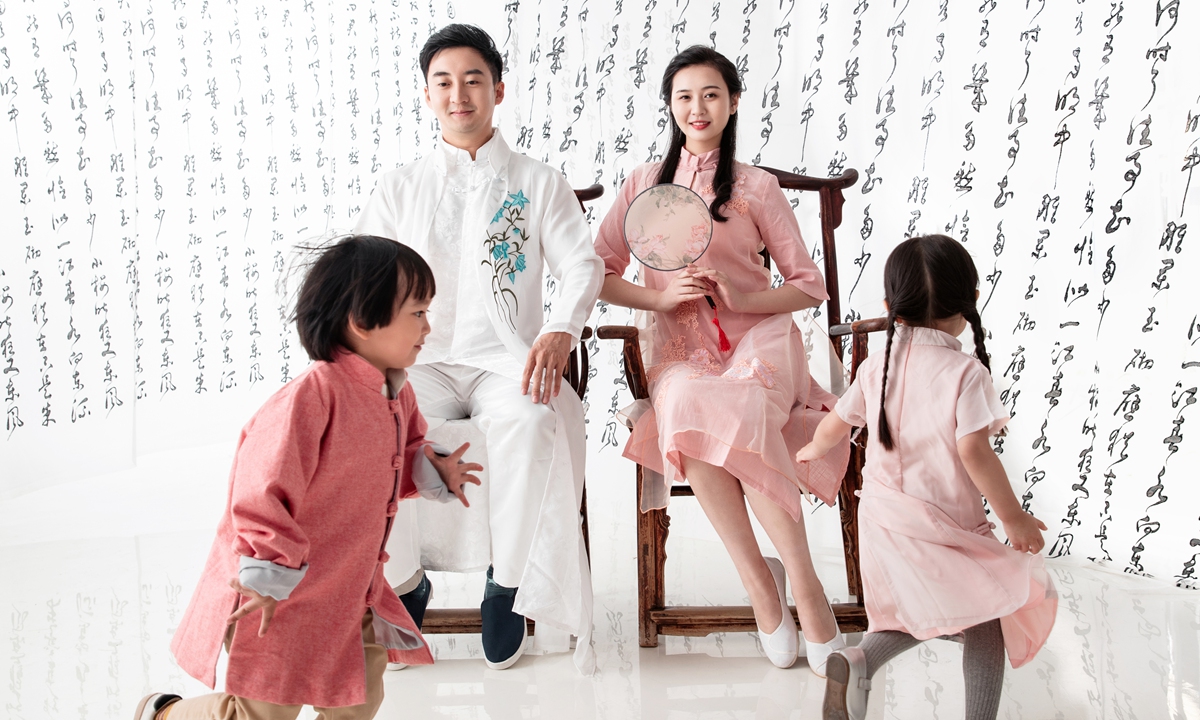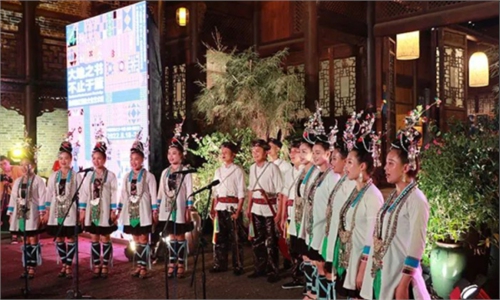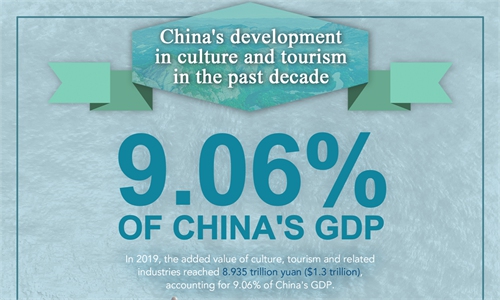ARTS / CULTURE & LEISURE
Neo-Chinese fashion spread wider by confident young people
Cultured and stylish

A family in Chinese style clothing Photo: VCG
On streets of Chinese cities, young people can increasingly be seen wearing clothing with "neo-Chinese elements." This style combining modern and traditional clothing such as qipao or hanfu has become a new favorite for younger generations, who have more confidence than ever in traditional Chinese culture.Data shows that in the second half of 2021, posts about "neo-Chinese wear" published on Chinese lifestyle-oriented social media platform Xiaohongshu increased greatly compared to the first half in 2021.
A report about recent fashion trends published by Chinese e-commerce giant Taobao noted that neo-Chinese fashion has mainly proven popular among 18- to 34-year-olds, while women aged 24-34 years old account for 40 percent of the consumer group.
"In 2013, when I first threw myself into the work of preserving traditional decorative patterns, those who gave me support and encouragement were mostly middle-aged people over 40. However, now most of our followers are in their 20s," Huang Qingsui, an ethnic Zhuang art designer, told the Global Times. The trend demonstrates that younger people in China are more confident and have a stronger sense of identity when it comes to the nation's traditional culture, Huang added.
This trend is not limited to clothing but also expands to items like home decor, fashion accessories and even hobbies such as taking part in tea ceremonies and practicing calligraphy.
Tradition-oriented fashion
What exactly is neo-Chinese style?
At present, a relatively basic definition is that it is a new interpretation of traditional Chinese culture in the modern era or contemporary design based on traditional culture.
Neo-Chinese style has spread into many fields, including neo-Chinese tea, neo-Chinese baking and neo-Chinese home decor.
Neo-Chinese clothing is one of the most popular fields among younger generations, who prefer clothing that integrates traditional Chinese elements into daily wear. This has inspired Chinese designers to use more traditional ornaments such as the buttons and loops of the Chinese frog button and wrap fronts when designing daily wear.
Compared with traditional hanfu or Tang jackets, neo-Chinese dresses exchange a sense of ceremony and solemnity for a more simple and convenient feel.
Designer Zhang Yan, who made his New York fashion week debut in 2019, focuses on finding inspirations in traditional Chinese culture such as Taoist philosophy. Zhang told the Global Times that embroidery has allowed him to slow down the pace of his life and stabilize his mental state. He is now trying to pass this leisurely attitude on to others through his clothing.
Lin Taile, a fashion lover, told the Global Times that her passion for the neo-Chinese fashion was ignited six years ago when she took a Chinese-embroidery jacket her aunt threw away and matched it with a pair of jeans and trainers.
Lin noted that when she wore her "neo-Chinese look" in the Paris metro, a local street photographer approached her and said, "You show your culture effortlessly in a stylish way."
Open mind about diversity
According to a McKinsey report about the trends that will shape Chinese consumption growth over the next decade, changes in consumer attitudes are driving the growth of local brands. Baidu search data shows that from 2009 to 2019, consumers' attention toward Chinese brands increased from 38 percent to 70 percent, with millennials becoming the main buyers of domestic products.
"The modern yet traditional aesthetics of neo-Chinese fashion intrigues young consumers because it represents 'who they are' through dress-up. It is a 'way to send a message,' speaking of their open mind about cultural diversity and even a challenge to stereotypes," Fang Qiongyi, a cultural sociologist in Shanghai, told the Global Times on Monday.
Going from a watercolor painter to a fashion designer, Guan Yishu uses artistic elements such as landscape painting and abstract ink painting to make her clothing designs stand out.
She has designed a casual suit made of organza silk adorned with Chinese buttons and abstract water-ink patterns to show "career women's professional yet life-loving qualities."
"The neo-Chinese style projects people's life desires. Once a customer told me she needed a Chinese dress to make her look modern, elegant, trustworthy for an important business pitch. I made her a little black dress popular in French culture with an understated Chinese silk jacquard pattern. She said she felt empowered by it."
"Neo-Chinese style also values inspiration from foreign cultures, or new movements close to people," Guan noted.
Qian Xiaoping, an 83-year-old national-level Song brocade inheritor, told the Global Times that designing silk clothing and everyday accessories brings her a great deal of excitement as it represents an opportunity to bring traditional Chinese designs to younger people.


